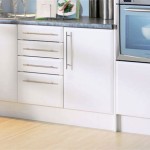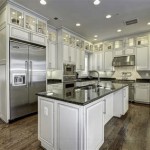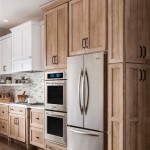Stained Wood Kitchen Cabinet Ideas: Enhancing Natural Beauty and Character
Stained wood kitchen cabinets offer a timeless appeal, emphasizing the natural grain and texture of the wood while providing a warm and inviting atmosphere. Unlike painted cabinets, stained wood allows the wood's inherent beauty to shine through, creating a unique and character-rich aesthetic. The selection of the right stain is critical to achieving the desired look, and understanding the properties of different wood species is equally important. This article explores various stained wood kitchen cabinet ideas, focusing on wood species, stain colors, design styles, and hardware considerations to elevate the overall kitchen design.
Choosing the Right Wood Species for Staining
The type of wood significantly impacts the final appearance of stained cabinets. Different wood species possess varying grain patterns, densities, and porosities, which influence how the stain is absorbed and how the color ultimately manifests. Understanding these variations is paramount for achieving the desired aesthetic.
Oak: Oak is a popular choice for stained kitchen cabinets due to its prominent grain pattern and durability. Red oak has a reddish undertone, while white oak exhibits a more neutral tannish hue. Oak's open grain structure readily accepts stain, highlighting the wood's natural features. It is a versatile wood that can accommodate a wide range of stain colors, from light natural tones to darker, richer shades.
Maple: Maple is a hardwood known for its tight, uniform grain and smooth surface. It is less porous than oak, resulting in a more even and consistent stain application. Maple typically showcases a lighter, more subtle grain pattern, making it an excellent choice for modern or contemporary kitchens where a sleek and refined look is desired. Maple's light color also makes it suitable for lighter stains, showcasing the wood's inherent warmth without overpowering the space.
Cherry: Cherry wood is prized for its rich reddish-brown color and smooth, fine grain. It deepens and burnishes with age, developing a beautiful patina over time. Cherry cabinets exude elegance and sophistication, making them a popular choice for traditional and transitional kitchens. Due to its natural color, cherry may only require a light stain or a clear coat to enhance its inherent beauty. Darker stains can further accentuate its richness, but it's important to consider the overall lighting in the kitchen to avoid creating a space that feels too dark.
Hickory: Hickory is a strong and durable wood with a bold, rustic grain pattern. It features dramatic variations in color, ranging from light tan to dark brown, creating a visually appealing and characterful appearance. Hickory cabinets are well-suited for country, farmhouse, and rustic kitchen styles. Staining hickory can enhance its natural variations, adding depth and dimension to the cabinets. However, it is essential to carefully select a stain that complements the wood's inherent tones to avoid a muddy or unbalanced look.
Alder: Alder is a softer hardwood that is often used as a substitute for more expensive woods like cherry or walnut. It has a relatively uniform grain and accepts stain well, making it a versatile option for a variety of kitchen styles. Alder is often stained to mimic the appearance of other woods, allowing homeowners to achieve a specific look at a more affordable price point. It can be stained in a range of colors, from light and natural to dark and dramatic.
Exploring Stain Colors and Finishes
The selection of the right stain color is crucial for achieving the desired aesthetic. Stain colors can range from light and natural to dark and dramatic, each offering a unique look and feel. The choice of stain color should complement the overall kitchen design, including the countertops, backsplash, flooring, and appliances.
Light Stains: Light stains, such as natural, honey, or whitewashed finishes, allow the wood's natural color and grain to shine through. These stains create a bright and airy feel, making them ideal for small kitchens or kitchens with limited natural light. Light stains are also a good choice for modern or minimalist kitchens where a clean and understated look is desired. They can be paired with light countertops and backsplashes to create a cohesive and harmonious space.
Medium Stains: Medium stains, such as cherry, maple, or walnut, offer a balance between light and dark tones. These stains provide warmth and depth to the cabinets without overpowering the space. They are versatile and can complement a variety of kitchen styles, from traditional to transitional. Medium stains can be paired with a range of countertop materials, from granite and quartz to butcher block and stainless steel.
Dark Stains: Dark stains, such as ebony, espresso, or mahogany, create a dramatic and sophisticated look. These stains add depth and richness to the cabinets, making them a focal point in the kitchen. Dark stains are well-suited for large kitchens with ample natural light. They can be paired with light countertops and backsplashes to create a striking contrast. However, it is important to use dark stains sparingly, as they can make a small kitchen feel cramped and dark.
Specialty Finishes: In addition to traditional stains, there are a variety of specialty finishes that can add unique character to stained wood cabinets. These include distressed finishes, which create a weathered and aged look; glazed finishes, which add depth and dimension; and antiqued finishes, which evoke a sense of history and charm. Specialty finishes are often used in country, farmhouse, and rustic kitchen styles.
The finish applied after the stain is equally important. The finish protects the wood from moisture, scratches, and other damage, while also enhancing the stain's color and sheen. Common finishes include lacquer, varnish, polyurethane, and oil-based finishes. The choice of finish depends on the desired level of durability and the overall aesthetic.
Integrating Stained Wood Cabinets into Different Kitchen Styles
Stained wood cabinets can be successfully integrated into a wide range of kitchen styles, from traditional to contemporary. The key is to select the right wood species, stain color, and hardware to complement the overall design aesthetic.
Traditional Kitchens: Traditional kitchens often feature raised-panel cabinet doors, ornate detailing, and rich, warm tones. Stained wood cabinets in cherry or walnut are a natural fit for traditional kitchens, exuding elegance and sophistication. Darker stains and glazed finishes can further enhance the traditional aesthetic. Hardware choices typically include antique brass or oil-rubbed bronze knobs and pulls.
Contemporary Kitchens: Contemporary kitchens typically feature clean lines, minimalist designs, and a focus on functionality. Stained wood cabinets in maple or oak can be used in contemporary kitchens, but it is important to select a light or medium stain to maintain a bright and airy feel. Flat-panel cabinet doors and sleek, modern hardware are common choices. The stain should highlight the clean lines and simplicity of the design.
Transitional Kitchens: Transitional kitchens blend elements of traditional and contemporary styles, creating a balanced and timeless look. Stained wood cabinets in a variety of wood species and stain colors can be used in transitional kitchens. The key is to select cabinet door styles and hardware that bridge the gap between traditional and contemporary design. Shaker-style cabinets are a popular choice for transitional kitchens.
Farmhouse Kitchens: Farmhouse kitchens evoke a sense of warmth, comfort, and rustic charm. Stained wood cabinets in hickory or alder are well-suited for farmhouse kitchens, showcasing the wood's natural character and grain. Light or medium stains and distressed finishes can further enhance the farmhouse aesthetic. Hardware choices typically include cup pulls and bin pulls in antique brass or black.
Rustic Kitchens: Rustic kitchens embrace natural materials, rugged textures, and a sense of ruggedness. Stained wood cabinets in hickory or knotty pine are a natural fit for rustic kitchens. Dark stains and heavily distressed finishes can further enhance the rustic aesthetic. Hardware choices typically include wrought iron or hammered metal knobs and pulls.
By carefully considering the wood species, stain color, and design style, homeowners can create a stained wood kitchen that is both beautiful and functional, reflecting their personal style and enhancing the overall ambiance of their home.
:strip_icc()/102182203-4cf08265c33b4c4e88fb21315a8fe626.jpg?strip=all)
Wood Cabinet Ideas To Consider For Your Kitchen Remodel

15 Stunning Kitchens With Stained Cabinets Sincerely Marie Designs Kitchen Pine Rustic

Kitchen Trend Wood Stained And Painted Cabinets Home Bunch Interior Design Ideas

15 Stunning Kitchens With Stained Cabinets Sincerely Marie Designs

12 Kitchens That Wow With Wood Cabinets

Wood Cabinets In The Kitchen Making A Comeback Town Country Living

15 Stunning Kitchens With Stained Cabinets Sincerely Marie Designs Kitchen Remodel Brown

12 Kitchens That Wow With Wood Cabinets

Kitchen Trend Wood Stained And Painted Cabinets Home Bunch Interior Design Ideas

The Comeback Of Wood Kitchen Cabinets Farmhousehub
Related Posts








